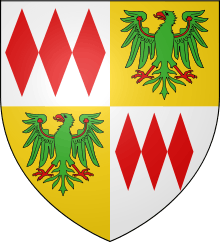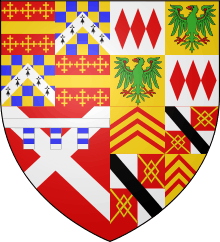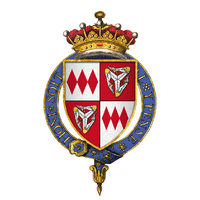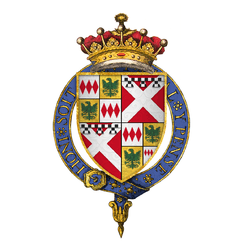Earl of Salisbury


Earl of Salisbury is a title that has been created several times in British history. It has a complex history, being first created for Patrick de Salisbury in the middle twelfth century. It was eventually inherited by Alice, wife of Thomas, Earl of Lancaster. When the Earl of Lancaster lost his titles and was executed for treason in 1322, the Countess surrendered all of her titles to the King, and the titles lapsed.
The title was created for a second time in 1337 for William Montacute. It was inherited later by Richard Neville the Kingmaker, upon whose death the title went into abeyance because multiple individuals were entitled to inherit it.
Then, in 1472, it was granted to George, Duke of Clarence, who was married to Warwick's eldest daughter. When the Duke of Clarence was executed in 1478 for treason (supposedly by being drowned in a vat of Malmsey wine), the title was forfeit. It was then granted to Edward of Middleham (who was his nephew via the Duke's brother Richard), who died in 1484 at the age of 11.
It was restored to two of George of Clarence's children: to his son Edward in 1485 until his execution for treason in 1499, and to Edward's sister, Margaret Pole, Countess of Salisbury, in 1513 until she was also executed, and the title again forfeited, in 1539.
In 1605 the title was given to Robert Cecil, 1st Earl of Salisbury, a close advisor to James I. Cecil was a son of Queen Elizabeth I's chief advisor, William Cecil, 1st Baron Burghley. For information on this creation, see the Marquess of Salisbury.
Earls of Salisbury, First Creation (1149)
- Patrick of Salisbury, 1st Earl of Salisbury (c. 1122-1168)
- William of Salisbury, 2nd Earl of Salisbury (d. 1196)
- Ela of Salisbury, 3rd Countess of Salisbury (1187–1261)
- William Longespée, 3rd Earl of Salisbury jure uxoris (c. 1176–1226)
- Margaret Longespée, 4th Countess of Salisbury (d. 1310)
- Alice de Lacy, 5th Countess of Salisbury (1281–1348) (forfeit 1322)
Earls of Salisbury, Second Creation (1337)
- William Montagu, 1st Earl of Salisbury (1301–1344)
-
 William Montagu, 2nd Earl of Salisbury (1328–1397)
William Montagu, 2nd Earl of Salisbury (1328–1397) -
 John Montagu, 3rd Earl of Salisbury (1350–1400) (forfeit 1400)
John Montagu, 3rd Earl of Salisbury (1350–1400) (forfeit 1400) -
 Thomas Montagu, 4th Earl of Salisbury (1388–1428) (restored 1421, although styled and summoned to parliament as such from at least 1409)
Thomas Montagu, 4th Earl of Salisbury (1388–1428) (restored 1421, although styled and summoned to parliament as such from at least 1409) - Alice Montacute, 5th Countess of Salisbury (1400–1460)
-
 Richard Neville, 5th Earl of Salisbury jure uxoris
Richard Neville, 5th Earl of Salisbury jure uxoris
-
-
 Richard Neville, 6th Earl of Salisbury and jure uxoris 16th Earl of Warwick ("Warwick the Kingmaker") by wife Lady Anne Beauchamp, 16th Countess of Warwick (1428–1471) (reverted to the crown 1471; by modern law it might, with his other titles, be abeyant).
Richard Neville, 6th Earl of Salisbury and jure uxoris 16th Earl of Warwick ("Warwick the Kingmaker") by wife Lady Anne Beauchamp, 16th Countess of Warwick (1428–1471) (reverted to the crown 1471; by modern law it might, with his other titles, be abeyant).
Earls of Salisbury, Third Creation (1472)
- George Plantagenet, 1st Earl of Salisbury (1449–1478) (forfeit 1478); son-in-law of the last Neville earl.
Earls of Salisbury, Fourth Creation (1478)
- Edward of Middleham, 1st Earl of Salisbury and later Prince of Wales (1473–1484); nephew of and nephew by marriage to George of Clarence, grandson of the last Neville earl (extinct 1484)
Earls of Salisbury, {Second or Third Creation (restored) or} Fifth Creation (1512)
Some sources call Edward Plantagenet, 17th Earl of Warwick (1475–1499) also Earl of Salisbury, but "there is no reason to suppose that he ever enjoyed that dignity".[1] He was son of George of Clarence above, and the other grandson of the last Neville Earl; if the modern doctrine of abeyance were retroactively applied to Earldoms - as it has not been - he would have inherited the Earldom of Salisbury in 1484; unless the creation of 1472 would be the termination of the abeyance. After 1485 he was kept in custody and did not attend the House of Lords under any title; in the intervening months, he was too young to sit. He was executed and attainted in 1499 at the age of 24, at which point all his titles, whatever they may have been, were forfeit. It is possible, however, that he had used it as a courtesy title, as it was a subsidiary title of his father.
- Margaret Plantagenet, Countess of Salisbury (1474–1541) (restored or created 1512; forfeit 1539), only sister of the above; sources differ on whether the Earldom of Salisbury restored to her was her father's (the third creation) or her grandfather's.
Earls of Salisbury, {Fifth or} Sixth Creation (1605)
- see the Marquess of Salisbury
Notes
- ↑ Complete Peerage, Vol. XI p. 399